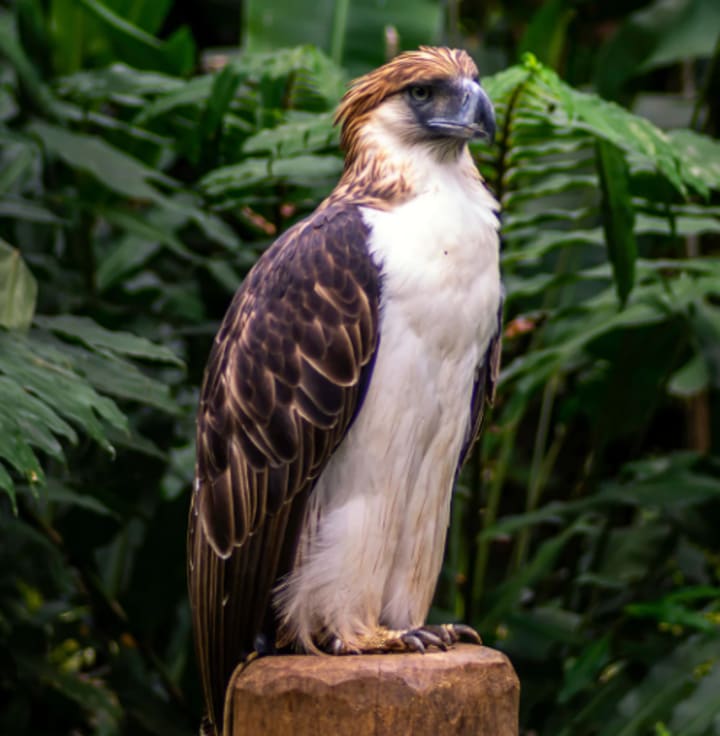Philippine Eagle
Habitat, Food and ETC.

The Philippine Eagle, also known as the monkey-eating eagle or Haribon, is a majestic and critically endangered bird species native to the Philippines. It is one of the largest and most powerful eagles in the world, with a wingspan of up to 7 feet (2.2 meters) and a length of about 3 feet (1 meter).
The Philippine Eagle is known for its striking appearance. It has a dark brown plumage, a creamy white underside, and piercing blue eyes. It has a prominent crest of feathers on its head, which gives it a regal and distinctive look. The species is named after the Philippines, its country of origin.
This eagle is predominantly found in the rainforests of the Philippines, particularly in the islands of Luzon, Samar, Leyte, and Mindanao. It inhabits areas with dense forest cover, preferably in mountainous regions. The species is known for its exceptional hunting skills, preying mainly on flying lemurs, monkeys, bats, and other small mammals, earning it the nickname "monkey-eating eagle."
Unfortunately, the Philippine Eagle is critically endangered, primarily due to habitat loss and fragmentation caused by deforestation and commercial logging. The species is also threatened by hunting and illegal trade. Conservation efforts are being made to protect this majestic bird, including the establishment of protected areas and breeding programs.
The Philippine Eagle has become an iconic symbol of the Philippines and is considered a national bird. It plays a significant role in the country's culture and conservation efforts, with various initiatives aimed at raising awareness and preserving its habitat.

The Philippine Eagle is primarily found in the rainforests of the Philippines. It inhabits various islands, including Luzon, Samar, Leyte, and Mindanao.
These eagles prefer dense, tropical lowland and montane forests with tall trees, particularly dipterocarp forests. They are often found in areas with rugged terrain, steep slopes, and deep valleys. The species has been observed at elevations ranging from sea level up to 7,200 feet (2,200 meters) in the mountains.
The Philippine Eagle requires large territories for hunting and breeding. They typically occupy home ranges that can extend over several square kilometers. The size of their territory depends on the availability of prey and suitable habitat. These eagles are known to be sensitive to habitat disturbance and prefer undisturbed forest areas.
Due to the restricted range of the species, the Philippine Eagle's habitat is mainly concentrated in a few regions of the Philippines. However, extensive deforestation and habitat loss have significantly reduced their suitable habitat. The conversion of forests for agriculture, logging activities, and infrastructure development poses a significant threat to the survival of this critically endangered species.
Conservation efforts are focused on protecting the remaining forested areas and establishing protected areas to safeguard the Philippine Eagle's habitat. These measures aim to ensure the preservation of the species and its associated biodiversity.

The Philippine Eagle, also known as the monkey-eating eagle, primarily feeds on a variety of prey items, including small to medium-sized mammals and birds. Its diet consists mainly of flying lemurs (colugos) and monkeys, such as macaques and flying squirrels.
The primary prey of the Philippine Eagle is the Philippine flying lemur (Cynocephalus volans), also known as the colugo. It is believed to make up a significant portion of their diet. The eagle is well adapted for hunting these arboreal mammals, with its strong talons and sharp beak. It can snatch them directly from the trees or catch them in mid-air.
Additionally, the Philippine Eagle preys on other mammals like palm civets, bats, rodents, and small deer when available. It also hunts various bird species, including hornbills, parrots, pigeons, and other forest-dwelling birds.
The diet of the Philippine Eagle is influenced by the availability of prey in its habitat. They are opportunistic hunters and will adapt their feeding habits based on what is accessible. Their diet may vary depending on factors such as prey abundance, seasonality, and local ecosystem dynamics.
As apex predators, the Philippine Eagles play an important role in maintaining the ecological balance of their habitat by controlling the populations of their prey species.
About the Creator
Dan IsEnjoyingLife
Chill, Relax and Enjoy Life is my Priority.
Please Subscribe for more Chilling, Relaxing and Enjoying Article, Thank You.






Comments
There are no comments for this story
Be the first to respond and start the conversation.